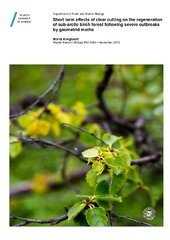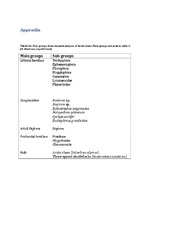Institutt for arktisk og marin biologi: Recent submissions
Now showing items 1801-1820 of 2049
-
Experimental harvest reveals the importance of territoriality in limiting the breeding population of Svalbard rock ptarmigan
(Journal article; Tidsskriftartikkel; Peer reviewed, 2013)The Svalbard rock ptarmigan (Lagopus muta hyperborea) is an endemic subspecies of rock ptarmigan inhabiting the high Arctic archipelagos of Svalbard and Franz Josefs Land. This ptarmigan species exists at low population densities, with little interannual variations in population numbers, and limited habitat for breeding with less than 5 % of the land area in Svalbard constituting medium to high ... -
New insights into regulation of anthocyanin biosynthesis in fruits
(Journal article; Tidsskriftartikkel; Peer reviewed, 2013)Anthocyanins are important health-promoting pigments that make a major contribution to the quality of fruits. The biosynthetic pathway leading to anthocyanins is well known and the key regulatory genes controlling the pathway have been isolated in many species. Recently, a considerable amount of new information has been gathered on the developmental and environmental regulation of anthocyanin ... -
What are the impacts of reindeer/caribou (Rangifer tarandus L.) on arctic and alpine vegetation? A systematic review protocol
(Journal article; Tidsskriftartikkel; Peer reviewed, 2013)Abstract Background: Reindeer and caribou (both belonging to the species Rangifer tarandus L.) are among the most important large herbivores in Eurasia’s and North America’s arctic, alpine and boreal zones. In Sweden, the impact of reindeer grazing on arctic and alpine vegetation has recently been re-evaluated. In the 1990s, records of grazing-related vegetation degradation helped to form a ... -
Shedding new light on the diet of Norwegian lemmings: DNA metabarcoding of stomach content
(Journal article; Tidsskriftartikkel; Peer reviewed, 2013)Lemmings are key herbivores in many arctic food webs, and their population dynamics have major impacts on the functioning of tundra systems. However, current knowledge of lemming diet is limited, hampering evaluation of lemming–vegetation interactions. This lack of knowledge is mainly due to methodological challenges, as previously used microhistological methods result in large proportions of poorly ... -
Fjellrev i Finnmark : Årsrapport 2013
(Research report; Forskningsrapport, 2013)Prosjekt Fjellrev i Finnmark har pågått siden 2004. Prosjektet har fra starten av hatt to målsetninger: Å gjøre grunnleggende forskning på økosystembetingelser som begrenser fjellrevenbestandens nåværende utbredelse og bestandsvekst i Øst-Finnmark spesielt, og i sub- og lav-Arktis generelt, med fokus på to hypoteser; a) mer uregelmessige og dempede smågnagersykler og b) øket konkurranse med ... -
Short term effects of clear cutting on the regeneration of sub-arctic birch forest following severe outbreaks by geometrid moths
(Master thesis; Mastergradsoppgave, 2013-11-08)Birch forests in northern Fennoscandia experience re-occurring mass outbreaks of pest insects often resulting in severe defoliation. Here I test whether systematic clear cutting can accelerate the forest regeneration after outbreaks with uncut control plots as comparison. Basal shoot abundance was used as a main indicator for recovery but comprehensive data sampling also included the abundance of ... -
Isolation of Fungal Endophytes from Grasses by Laser Micro Dissection & Pressure Catapulting
(Master thesis; Mastergradsoppgave, 2013-12-12)A very diverse group of fungi capable of forming endophytic associations may have profound consequences for natural ecosystems as well as for cultivated plants. Fungal endophytes may benefit their host plants by producing secondary metabolites, and may be an important source for bioactive antimicrobial compounds, used in agriculture, commercial industry, and in medicine. Earlier studies on endophytes ... -
Temporal trends of POPs in arctic foxes from Svalbard in light of a changing climate
(Master thesis; Mastergradsoppgave, 2013-11-15)The present study investigates concentrations and temporal trends of persistent organic pollutants (POPs) in arctic foxes (Vulpes lagopus) from Svalbard, Norway, adjusted for sex, age, body condition, diet, reindeer mortality and sea ice coverage. Number of reindeer carcasses in Adventdalen and sea ice coverage of Isfjorden in the spring preceding the trapping season were used as indexes for climate ... -
Alternative prey choice in the pteropod Clione limacina (Gastropoda) studied by DNA-based methods
(Master thesis; Mastergradsoppgave, 2013-11-15)The gymnosome pteropod Clione limacina is regarded as a monophagous predator, feeding exclusively on the thecosome pteropod Limacina helicina in Arctic waters. C. limacina is adapted to survive periods of low food availability by long-term starvation. Although L. helicina is absent from the water, a number of other zooplankton species are present during this time. It may therefore seem surprising ... -
Morphological divergence in a trimorphic population of Arctic charr (Salvelinus alpinus (L.)) in Skogsfjordvatn, northern Norway.
(Master thesis; Mastergradsoppgave, 2013-09-30)Sympatric polymorphisms are found in many freshwater fish taxa, including the salmonid Arctic charr (Salvelinus alpinus (L.)). Polymorphism is often expressed as differences in morphology, behaviour and life-history strategies, and may be driven by alternative phenotypic adaptations to resource use such as habitat and prey preferences. Morphological divergence is usually linked to different functions ... -
Parallel and non-parallel morphological divergence among foraging specialists in European whitefish (Coregonus lavaretus)
(Journal article; Tidsskriftartikkel; Peer reviewed, 2013)Parallel phenotypic evolution occurs when independent populations evolve similar traits in response to similar selective regimes. However, populations inhabiting similar environments also frequently show some phenotypic differences that result from non-parallel evolution. In this study, we quantified the relative importance of parallel evolution to similar foraging regimes and nonparallel lake-specific ... -
Cellulase activity screening using pure carboxymethylcellulose: Application to soluble cellulolytic samples and to plant tissue prints.
(Journal article; Tidsskriftartikkel; Peer reviewed, 2014)Reliable, rapid and inexpensive detection of cellulolytic enzymes that can be used for a wide variety of biological and environmental samples are currently in high demand. Here, a new cellulase detection protocol is described that circumvents problems observed with popular agar-based methods by exploiting the ability of carboxymethylcellulose (CMC) to form gel-like surfaces on its own. These pure ... -
Chemical Diversity as a Function of Temperature in Six Northern Diatom Species
(Journal article; Tidsskriftartikkel; Peer reviewed, 2013)In this study, we investigate how metabolic fingerprints are related to temperature. Six common northern temperate diatoms (Attheya longicornis, Chaetoceros socialis, Chaetoceros furcellatus, Porosira glacialis, Skeletonema marinoi, and Thalassiosira gravida) were cultivated at two different temperatures, 0.5 and 8.5 °C. To exclude metabolic variations due to differences in growth rates, the growth ... -
Snow cover and extreme winter warming events control flower abundance of some, but not all species in high arctic Svalbard
(Journal article; Tidsskriftartikkel; Peer reviewed, 2013)The High Arctic winter is expected to be altered through ongoing and future climate change. Winter precipitation and snow depth are projected to increase and melt out dates change accordingly. Also, snow cover and depth will play an important role in protecting plant canopy from increasingly more frequent extreme winter warming events. Flower production of many Arctic plants is dependent on melt ... -
Model of Tryptophan Metabolism, Readily Scalable Using Tissue-specific Gene Expression Data
(Journal article; Tidsskriftartikkel; Peer reviewed, 2013)Tryptophan is utilized in various metabolic routes including protein synthesis, serotonin, and melatonin synthesis and the kynurenine pathway. Perturbations in these pathways have been associated with neurodegenerative diseases and cancer. Here we present a comprehensive kinetic model of the complex network of human tryptophan metabolism based upon existing kinetic data for all enzymatic conversions ... -
Discrete foraging niches promote ecological, phenotypic, and genetic divergence in sympatric whitefish (Coregonus lavaretus)
(Journal article; Tidsskriftartikkel; Peer reviewed, 2012)Natural populations often vary in their degree of ecological, morphological and genetic divergence. This variation can be arranged along an ecological speciation continuum of increasingly discrete variation, with high inter-individual variation at one end and well defined species in the other. In postglacial fishes, evolutionary divergence has commonly resulted in the co-occurrence of a pelagic and ... -
A range-wide synthesis and timeline for phylogeographic events in the red fox (Vulpes vulpes)
(Journal article; Tidsskriftartikkel; Peer reviewed, 2013)Many boreo-temperate mammals have a Pleistocene fossil record throughout Eurasia and North America, but only few have a contemporary distribution that spans this large area. Examples of Holarctic-distributed carnivores are the brown bear, grey wolf, and red fox, all three ecological generalists with large dispersal capacity and a high adaptive flexibility. While the two former have been examined ... -
Silica accumulation in grasses in response to a large scale herbivore exclosure experiment
(Master thesis; Mastergradsoppgave, 2011-06-10)Silica defenses in grasses have been recently proposed to be important for plant-herbivore interactions. High silica levels in grasses have been found to have a negative impact on herbivores performance and act as an herbivory deterrent. Moreover, accumulation of silica has been proposed to be inducible, i.e. highly grazed grasses accumulate silica in their leaves. In order to assess whether silica ... -
Ecological speciation in postglacial European whitefish: rapid adaptive radiations into the littoral, pelagic, and profundal lake habitats
(Journal article; Tidsskriftartikkel; Peer reviewed, 2013)Understanding how a monophyletic lineage of a species diverges into several adaptive forms has received increased attention in recent years, but the underlying mechanisms in this process are still under debate. Postglacial fishes are excellent model organisms for exploring this process, especially the initial stages of ecological speciation, as postglacial lakes represent replicated discrete ... -
What Do the IUCN Categories Really Protect? A Case Study of the Alpine Regions in Spain.
(Journal article; Tidsskriftartikkel; Peer reviewed, 2013)Protected area (PA) coverage is used as an indicator of biodiversity protection worldwide. The effectiveness of using PAs as indicators has been questioned due to the diversity of categories encompassed by such designations, especially in PAs established for purposes other than biodiversity protection. Although international standards have been developed by the International Union for Conservation ...


 English
English norsk
norsk


















